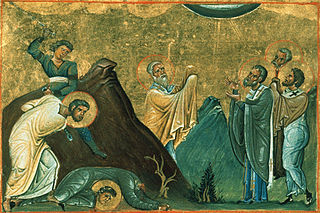Related Research Articles
Malachi, also known as Malachias, is the traditional author of the Book of Malachi, the last book of the Nevi'im (Prophets) section of the Tanakh. According to the 1897 Easton's Bible Dictionary, it is possible that Malachi is not a proper name, as it simply means "messenger".
Anakim are mentioned in the Bible as a race of giants, descended from Anak.

The Illustrated Bible Dictionary, better known as Easton's Bible Dictionary, is a reference work on topics related to the Christian Bible, compiled by Matthew George Easton. The first edition was published in 1893, and a revised edition was published the following year. The most popular edition, however, was the third, published by Thomas Nelson in 1897, three years after Easton's death. The last contains nearly 4,000 entries relating to the Bible. Many of the entries in Easton's are encyclopedic in nature, although there are also short dictionary-type entries.
Zaretan or Zarethan, also known as Zeredathah, is a city mentioned in the Hebrew Bible as near the location where the Hebrews crossed the Jordan. In the books of Joshua and 1 Kings, it is called Zarethan, but in 2 Chronicles it is called Zeredathah.
Shebna was the royal steward in the reign of king Hezekiah of Judah, according to the Hebrew Bible.
Ramoth-Gilead, was a Levitical city and city of refuge east of the Jordan River in the Hebrew Bible, also called "Ramoth in Gilead" or "Ramoth Galaad" in the Douay–Rheims Bible. It was located in the tribal territorial allotment of the tribe of Gad.
Matthew George Easton was a Scottish minister and writer. His most known work is the Illustrated Bible Dictionary (1893), later known as Easton's Bible Dictionary.

Ibzan or Ivtzan appears in the Hebrew Bible as the ninth of the Judges of Israel.

In the Hebrew Bible/Old Testament Book of Job, Zopharthe Naamathite is one of the three friends of Job who visit to comfort him during his illness. His comments can be found in Job 11:1–20 and Job 20:1–29. He suggests that Job's suffering could be divine punishment, and goes into great detail about the consequences of living a life of sin.
Aphik or Afik, in the Bible, is a city in the Tribe of Asher from which the Canaanites were not driven out, identified with the Aphaca of classical times, the modern Afka, or alternatively with Tel Afek near Haifa. "And Asher did not dispossess the ones living in Accho, and the ones living in Sidon, and Ahlab, and Achzib, and Helbah, and Aphik, and Rehob".
Sopater was the son of Pyrhus, a man from the city of Berea, mentioned in Acts 20:4. Sopater and others accompanied Paul out of Macedonia after a group of Jews began to plot against Paul, and then sailed from Philippi to Alexandria Troas where they met Paul who had gone by land.

Enos or Enosh is a figure in the Book of Genesis in the Hebrew Bible. He is described as the first son of Seth who figures in the Generations of Adam, and is also referred to within the genealogies of 1 Chronicles.
Kinah, ḳinah or qinah is Hebrew for a dirge or lamentation. Its general meaning is a dirge or lament, especially as sung by Jewish professional mourning women. Specifically, it can refer to one of the many Hebrew elegies chanted traditionally on Tisha B'Av. The Jerusalem Bible refers to Isaiah 47 as a qinah or "lament for Babylon", and to Ezekiel 19 as a qinah or lamentation over the rulers of Israel. A. W. Streane suggests that Jeremiah 22:6-7, on the prophesied downfall of Jerusalem, is written "in Ḳinah metre".
Kir of Moab is mentioned in the Hebrew Bible as one of the two main strongholds of Moab, the other being Ar. It is probably the same as the city called Kir-haresh, Kir-hareseth, and Kir-heres. The word Kir alludes to a wall or fortress. It is identified with the later city Al Karak.
Lebonah was a town near Shiloh, on the north side of Bethel, mentioned in the Hebrew Bible. It has been identified with Al-Lubban ash-Sharqiya, to the south of Nablus.

Olympas was a Roman Christian whom Paul of Tarsus saluted in around 65 AD.
Shur is a location mentioned several times in the Hebrew Bible.
Helam is a Hebrew Bible place name. According to 2 Samuel 10:15-18, Helam was the site of King David's victory over the Syrians under Hadarezer. It may be associated with modern Alma, Israel, about 55 km (34 mi) east of the Sea of Galilee.
References
- ↑ נאמן, פנחס (1968). "מסע סנחריב לא"י בשנת 701". Beit Mikra: Journal for the Study of the Bible and Its World. 13 (2 (33)): 71. ISSN 0005-979X.
![]() This article incorporates text from a publication now in the public domain: Easton, Matthew George (1897). "Ahlab". Easton's Bible Dictionary (New and revised ed.). T. Nelson and Sons.
This article incorporates text from a publication now in the public domain: Easton, Matthew George (1897). "Ahlab". Easton's Bible Dictionary (New and revised ed.). T. Nelson and Sons.